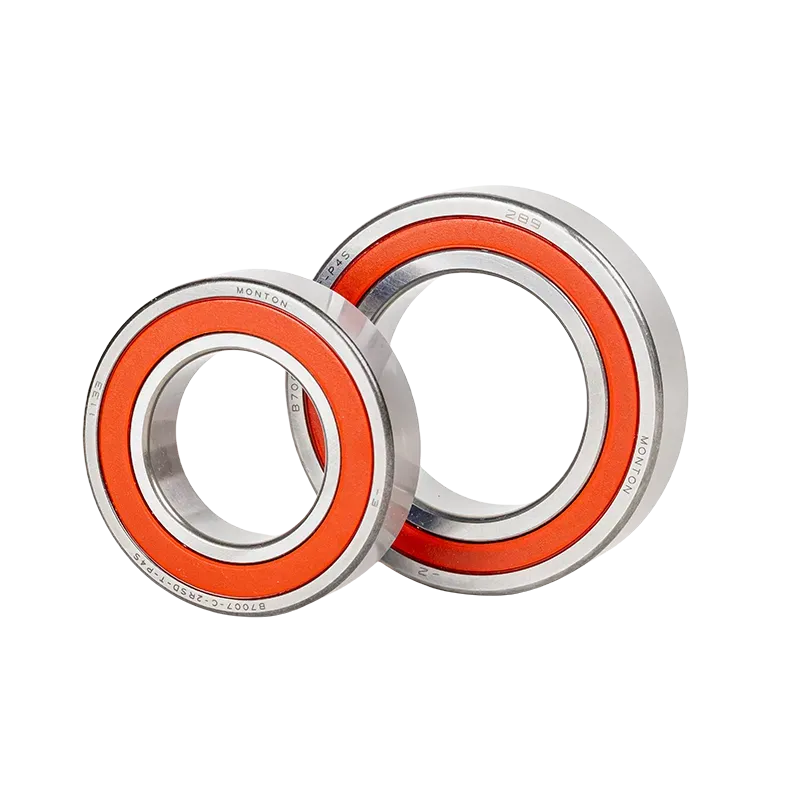Time: 2024-09-05 01:46:11 Source: Luoyang Monton Bearing Science & Technology Co.,ltd.
Angular contact ball bearings are important components in mechanical transmission systems, and their installation methods are directly related to the operational stability of the equipment and the service life of the bearings. Today, the editor will introduce in detail several common installation methods of angular contact ball bearings, including back-to-back installation, face-to-face installation, tandem installation and positioning installation, and discuss the advantages, disadvantages and applicable scenarios of each method.

1. Back-to-back installation (DB combination)
Back-to-back installation refers to placing the wide end faces of two angular contact ball bearings opposite each other. This installation method can significantly enhance the support stiffness of the bearings in the radial and axial directions and provide excellent resistance to deformation. Since the contact angle line spreads in the direction of the axis, the support angle rigidity of the bearing is increased, and it is suitable for applications that bear large axial loads and impact loads. However, it should be noted that due to the small internal clearance, the stiffness of the bearing may be increased, thereby affecting its life.
During installation, ensure that the wide end faces of the two bearings fit closely and the axial positioning is accurate to avoid deflection and wear caused by improper installation.
2. Face-to-face installation (DF combination)
Face-to-face installation is to place the narrow end faces of two angular contact ball bearings opposite each other. This installation method is suitable for occasions that bear small axial load and impact load. Compared with back-to-back mounting, bearings mounted face-to-face have greater internal clearance, which helps reduce the stiffness of the bearing and thus increases its life. However, due to the poor automatic adjustment capability of the contact angle, more precise axial positioning and adjustment are required.
During installation, it is necessary to ensure that the narrow end faces of the two bearings are in close contact, and to optimize the working condition of the bearings by adjusting the preload force.
3. Series installation (DT combination)
Series installation is to connect multiple angular contact ball bearings in series so that their wide end surfaces face the same direction and the contact angle lines remain parallel in the same direction. This installation method is suitable for occasions that bear large radial loads and impact loads. The advantage of tandem installation is that it can improve the stiffness and load-bearing capacity of the bearing while reducing internal friction and heat generation. However, in order to ensure axial stability, the bearings arranged in series must be installed correspondingly at both ends of the shaft, and more precise axial positioning and adjustment are required.
4. Positioning and installation
Positioning installation is to fix one ring of the angular contact ball bearing on the shaft, and the other ring is fixed on the body. This installation method is suitable for high-speed rotation situations, which can significantly improve the stiffness and accuracy of the bearing and reduce vibration and noise. However, positioning installation also requires precise axial positioning and adjustment to avoid wear and heat caused by improper installation.
Cleaning and inspection: Before installation, be sure to check whether the bearing seat is clean and free of wear, and remove all impurities and foreign matter.
Sequence and direction: Assemble in the correct order and direction to avoid bearing misalignment or jamming.
Preload adjustment: Adjust the preload of the bearing according to actual needs to ensure its working performance.
Rotation test: After installation, perform a rotation test to check the operation, noise, vibration, temperature rise and other indicators of the bearing to ensure that everything is normal.
Lubrication and protection: Select appropriate grease/oil for lubrication according to the specifications formulated by the factory process department, and take protective measures such as rust prevention.
There are many ways to install angular contact ball bearings, each of which has its own unique advantages and disadvantages and applicable scenarios. When choosing an installation method, you should make comprehensive considerations based on the actual situation to ensure that the performance and life of the bearing are in the best state.